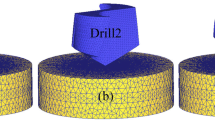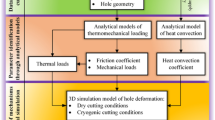Abstract
A comprehensive 3D finite element simulation study has been conducted to investigate the tool temperature distribution along cutting edge and chip formation during drilling of Ti6Al4V alloy by using commercial finite element software Abaqus/Explicit. The Johnson–Cook material constitutive model and material failure criterion were implemented across the formulations to achieve the tool temperature and chip formation in the drilling process. The effect of different mesh sizes on simulation results was also analyzed. To assess and verify the accuracy of the simulation model, the corresponding experiment studies were carried out by measuring the thrust force, tool temperature, and chip morphology. Compared results show that the predicted thrust force, temperature distribution, and chip morphology are in good agreement with those tested from experiments. According to the combination of both simulations and experiments, it can be not only found the whole varying pattern of the thrust force but also reveal that the temperature decreases from drill center to outer corner along the primary cutting edge. In addition, it can provide a more detailed and profound knowledge about chip formation. All these are assumed to be recommendations for the optimization of tool geometry and drilling processing.


















Similar content being viewed by others
Availability of data and materials
The raw/processed data required to reproduce these findings cannot be shared at this time as the data also forms part of an ongoing study.
Code availability
Not applicable.
References
Rey PA, Ledref J, Senatore J, Landon Y (2016) Modelling of cutting forces in orbital drilling of titanium alloy Ti–6Al–4V. Int J Mach Tools Manuf 106:75–88. https://doi.org/10.1016/j.ijmachtools.2016.04.006
Han RD, Wu J (2010) Finite element simulation of drilling based on third wave systems AdvantEdge. Key Eng Mater 431–432:229–232. https://doi.org/10.4028/www.scientific.net/KEM.431-432.229
Sorgato M, Bertolini R, Ghiotti A, Bruschi S (2021) Tool wear analysis in high-frequency vibration-assisted drilling of additive manufactured Ti6Al4V alloy. Wear 477:1–12. https://doi.org/10.1016/j.wear.2021.203814
Zhu ZJ, Sui SC, Sun J, Li JF, Li YL (2017) Investigation on performance characteristics in drilling of Ti6Al4V alloy. Int J Adv Manuf Technol 93:651–660. https://doi.org/10.1007/s00170-017-0508-6
Zhu ZJ, Guo K, Sun J, Li JF, Liu Y, Zheng YH, Chen L (2018) Evaluation of novel tool geometries in dry drilling aluminium 2024–T351/titanium Ti6Al4V stack. J Mater Process Technol 259:270–281. https://doi.org/10.1016/j.jmatprotec.2018.04.044
Balaji M, Venkata RK, Mohan RN, Murthy BSN (2018) Optimization of drilling parameters for drilling of TI-6Al-4V based on surface roughness, flank wear and drill vibration. Measurement 114:332–339. https://doi.org/10.1016/j.measurement.2017.09.051
Barman A, Adhikari R, Bolar G (2020) Evaluation of conventional drilling and helical milling for processing of holes in titanium alloy Ti6Al4V. Mater Today Proc 28:2295–3000. https://doi.org/10.1016/j.matpr.2020.04.573
Lotfi M, Amini S, Al-Awady IY (2018) 3D numerical analysis of drilling process: heat, wear, and built-up edge. Adv Manuf 6:204–214. https://doi.org/10.1007/s40436-018-0223-z
Hu F, Xie L, Xiang J, Umer U, Nan X (2018) Finite element modelling study on small-hole peck drilling of SiCp/Al composites. Int J Adv Manuf Technol 96:3719–3728. https://doi.org/10.1007/s00170-018-1730-6
Nan X, Xie L, Zhao W (2015) On the application of 3D finite element modeling for small-diameter hole drilling of AISI 1045 steel. Int J Adv Manuf Technol 84:1927–1939. https://doi.org/10.1007/s00170-015-7782-y
Bonnet C, Pottier T, Landon Y (2021) Development of a multi-scale and coupled cutting model for the drilling of Ti-6Al-4V. CIRP J Manuf Sci Technol 35:526–540. https://doi.org/10.1016/j.cirpj.2021.08.007
Isbilir O, Elaheh G (2011) Finite element analysis of drilling of titanium alloy. Procedia Eng 10:1877–1882. https://doi.org/10.1016/j.proeng.2011.04.312
Girinon M, Valiorgue F, Karaouni H, Feulvarch É (2018) 3D numerical simulation of drilling residual stresses. Comptes Rendus Mécanique 346:701–711. https://doi.org/10.1016/j.crme.2018.06.003
Priest J, Ghadbeigi H, Avar-Soberanis S, Gerardis S (2021) 3D finite element modelling of drilling: the effect of modelling method. CIRP J Manuf Sci Technol 35:158–168. https://doi.org/10.1016/j.cirpj.2021.06.001
Yıldız A, Kurt A, Yağmur S (2020) Finite element simulation of drilling operation and theoretical analysis of drill stresses with the deform-3D. Simul Model Pract Theory 104:102153. https://doi.org/10.1016/j.simpat.2020.102153
Korkmaz ME (2020) Verification of Johnson-Cook parameters of ferritic stainless steel by drilling process: experimental and finite element simulations. J Market Res 9:6322–6330. https://doi.org/10.1016/j.jmrt.2020.03.045
Matsumura T, Tamura S (2015) Cutting simulation of titanium alloy drilling with energy analysis and FEM. Procedia CIRP 31:252–257. https://doi.org/10.1016/j.procir.2015.03.045
Lazoglu I, Poulachon G, Ramirez C, Akmal M, Marcon B, Rossi F, Outeiro JC, Krebs M (2017) Thermal analysis in Ti-6Al-4V drilling. CIRP Ann 66:105–108. https://doi.org/10.1016/j.cirp.2017.04.020
Chatterjee S, Mahapatra SS, Abhishek K (2016) Simulation and optimization of machining parameters in drilling of titanium alloys. Simul Model Pract Theory 62:31–48. https://doi.org/10.1016/j.simpat.2015.12.004
Fan LY, Wang DZ (2021) Study on delamination inhibition and chip breakage mechanism in drilling metal laminated materials with double cone drill. J Manuf Process 64:81–94. https://doi.org/10.1016/j.jmapro.2021.01.014
Hao ZP, Li JN, Fan YH, Ji FF (2019) Study on constitutive model and deformation mechanism in high speed cutting Inconel718. Arch Civil Mech Eng 19:439–452. https://doi.org/10.1016/j.acme.2018.11.009
Wang B, Liu ZQ (2016) Evaluation on fracture locus of serrated chip generation with stress triaxiality in high speed machining of Ti6Al4V. Mater Des 98:68–78. https://doi.org/10.1016/j.matdes.2016.03.012
Johnson GR (1983) A constitutive model and data for materials subjected to large strains, high strain rates, and high temperatures. Proc Inf Sympo Ballistics 541–547
Umbrello D (2008) Finite element simulation of conventional and high speed machining of Ti6Al4V alloy. J Mater Process Technol 196:79–87. https://doi.org/10.1016/j.jmatprotec.2007.05.007
ABAQUS I (2004) ABAQUS analysis user’s manual: version 6–5. Rising Sun Mills, Providence 2
Zhang YC, Mabrouki T, Nelias D, Gong YD (2011) Chip formation in orthogonal cutting considering interface limiting shear stress and damage evolution based on fracture energy approach. Finite Elem Anal Des 47:850–863. https://doi.org/10.1016/j.finel.2011.02.016
Zhang YC, Mabrouki T, Nelias D, Gong YD (2011) FE-model for titanium alloy (Ti-6Al-4V) cutting based on the identification of limiting shear stress at tool-chip interface. IntJ Mater Form 4:11–23. https://doi.org/10.1007/s12289-010-0986-7
Childs THC (2006) Friction modelling in metal cutting. Wear 260:310–318. https://doi.org/10.1016/j.wear.2005.01.052
Zorev NN (1963) Inter-relationship between shear processes occurring along tool face and shear plane in metal cutting. Int Res Prod Eng 49:143–152
Barrow G, Graham W, Kurimoto T, Leong YF (1982) Determination of rake face stress distribution in orthogonal machining. Int J Mach Tool Des Res 22:75–85. https://doi.org/10.1016/0020-7357(82)90022-1
Barrow G, Graham W, Kurimoto T, Leong YF (1995) Determination of stress distribution on the tool rake face using a composite tool. Int J Mach Tools Manuf 35:373–382. https://doi.org/10.1016/0890-6955(94)E0020-J
Kato S, Yamaguchi K, Yamada M (1972) Stress Distribution at the Interface Between Tool and Chip in Machining. J Eng Ind 94:683–689. https://doi.org/10.1115/1.3428229
Chen L, Tai BL, Chaudhari RG, Song XZ, Shih AJ (2017) Machined surface temperature in hard turning. Int J Mach Tools Manuf 121:10–21. https://doi.org/10.1016/j.ijmachtools.2017.03.003
Bono M, Ni J (2002) A method for measuring the temperature distribution along the cutting edges of a drill. J Manuf Sci Eng Trans ASME 124(4):921–930. https://doi.org/10.1115/1.1511525
Zhu ZJ, Guo K, Sun J, Li JF, Liu Y, Chen L, Zheng YH (2018) Evolution of 3D chip morphology and phase transformation in dry drilling Ti6Al4V alloys. J Manuf Process 34:531–539. https://doi.org/10.1016/j.jmapro.2018.07.001
Funding
This work is financially supported by Natural and Science Foundation of Fujian Province under grant numbers 2021J01560 and Education and scientific research foundation for young teachers in Fujian Province under grant numbers JAT190006.
Author information
Authors and Affiliations
Contributions
Zhaoju Zhu and Bingwei He worked on conceptualization, methodology, formal analysis, and preparation of the original draft with input from all authors. Yunqi Zhu and Xinhui Sun developed the computational modal, design optimization, and conducted the experiments. Chuhang Gao and Maozhi Lin worked on data collection, processing, and segmentation. Zhaoju Zhu supervised the project.
Corresponding author
Ethics declarations
Ethics approval
Not applicable.
Consent to participate
Not applicable.
Consent to publication
Not applicable.
Conflict of interest
The authors declare no competing interests.
Additional information
Publisher's Note
Springer Nature remains neutral with regard to jurisdictional claims in published maps and institutional affiliations.
Rights and permissions
About this article
Cite this article
Zhu, Z., Zhu, Y., Sun, X. et al. 3D finite element simulation for tool temperature distribution and chip formation during drilling of Ti6Al4V alloy. Int J Adv Manuf Technol 121, 5155–5169 (2022). https://doi.org/10.1007/s00170-022-09543-z
Received:
Accepted:
Published:
Issue Date:
DOI: https://doi.org/10.1007/s00170-022-09543-z




